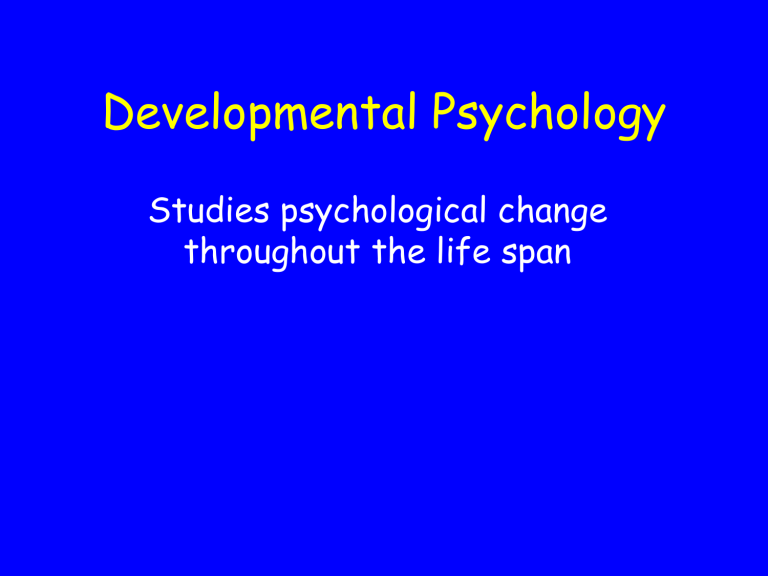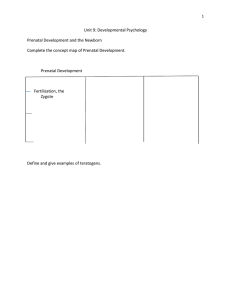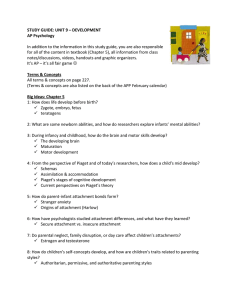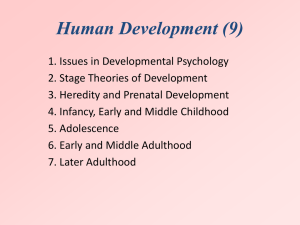
Developmental Psychology Studies psychological change throughout the life span Big Questions in Developmental Psychology Nature/Nurture: Is development due mostly to internal or external influences? Nature/Nurture • Maturation: A key nature Concept – Defined: Biological process that enables orderly changes in behavior How we know the behavior is due to maturation Criteria: 1. universal 2. sequential 3. relatively uninfluenced by experience Maturation? Nature/Nurture • Maturation: A key nature concept • Critical Period: A key nurture concept A specific period during development when a specific kind of stimulation (or lack of stimulation) can have a profound effect on later development Stages of Prenatal Development • conception (fertilization) • zygote (0-2 wks) • embryo (2-8 wks) – rapid cell division; major organs present • fetal period (8 wks-birth) – further refining of organs, etc Teratogens: Agents harmful to organism • Drugs – cigarettes; alcohol (FAS); cocaine; heroin; marijuana • Diseases – Rubella and critical periods The Importance of Nutrition At birth 3 months 15 months Cortical Neurons Neonate: Apgar Score Observation 0 1 2 Heart Rate Absent <100/min. >100/min. Respiration No breath Shallow Regular Muscle Tone Flaccid Some Flex Resp to Stim None of feet Well flexed Cry Some motion Pink body, Completely Blue Pink extremities Color Blue, pale Apgar Score: The First Test! Newborn Capabilities • Reflexes – rooting; sucking; stepping, Babinski; grasping; Moro Newborn Capabilities • Reflexes – Rooting; grasping; Babinski; smiling • Personality – Easy, Difficult, Slow-to-Warm • Preferences – High contrast; movement; face-like objects; smell of mom! Inborn Preferences! • human voices and faces facelike images--> • smell and sound of mother preferred Social Development: Attachment in Infants • Secure Attachment – – – – prefers contact with loved one can be soothed follows loved one cries when loved one leaves Stranger Anxiety: An Indication of Attachment Stranger Anxiety: infant is apprehensive when confronted by a stranger (approx 6 mo. old) Stranger Anxiety Across Cultures (maturation?) Separation Distress: Another Indication of Attachment Percentage of infants 100 who cried when their mothers left 80 • Groups of infants who had and had not experienced day care were left by their mothers in a unfamiliar room Day care 60 40 Home 20 0 3.5 5.5 7.5 9.5 11.5 13.5 20 Age in months 29 Love in Infant Monkeys: Experiments in Attachment (Harlow’s Studies) Experiments in Attachment Measurement of Attachment (Harlow’s studies) 1. Preference for “contact comfort” Experiments in Attachment Measurement of Attachment (Harlow’s Studies) 2. Fear reduction Experiments in Attachment Measurement of Attachment (Harlow’s studies) 3. Secure base (for exploration) The Importance of Attachment • Monkeys raised by artificial mothers were terror-stricken when placed in strange situations without their surrogate mothers Causes of Secure Attachment • Body Contact (Harlow’s studies) • Familiarity • Responsive Parenting Body Contact • Harlow’s Surrogate Mother Experiments – Monkeys preferred contact with the comfortable cloth mother, even while feeding from the nourishing wire mother Familiarity • Critical Period for imprinting • Imprinting: at 12 hours after birth, ducklings attach to objects that move Responsive Parenting • Responsive parents: are sensitive to child’s needs and meet them quickly • Unresponsive parents: attend to baby when they feel like it, and ignore the baby at other times Parenting Styles Warm Cold Lots of Authoritative Punitive Guidance (High Self-Esteem (Aggression) and Achievment) Little Permissive Neglectful Guidance (Low Self-Control) (Low SelfEsteem) The Continuity Question • Do neglected children become unresponsive parents? • The answer: it’s common but not inevitable The Child: Cognitive Development • Cognitive: to know • Scheme: a unit of knowledge • Three Kinds of Schemes – motor – images – symbolic Stages of Cognitive Development • All Children go through 4 stages • Stages are sequential • Rate depends on Maturation and Experience Stage 1: Sensorimotor (0-2) • Child knows world mostly through motor schemes Knowing through Motor Schemes • After sucking on one of these, babies looked longer at the nipple they had felt in their mouth Stage 1: Sensorimotor (0-2) • Child knows world mostly through motor schemes • Child is learning connections between sensations and motor actions (sensorimotor) • Key development: Object Permanence – objects continue to exist even when not visible Object Permanence Stage 2: Preoperational (2-6) • Child is not logical • Key development: Egocentrism – incapable of seeing another point of view Stage 3: Concrete Operational (7-11) • Thinks logically about concrete events • Key development: Conservation – objects stay the same even when their form changes Stage 4: Formal Operational (11-) • Able to think logically • Key development: Abstract thinking Piaget’s Theory and Education • To teach effectively, you must know how the child is thinking Moral Development Postconventional level Right vs wrong is decided by universal values Conventional level Right vs wrong depends on following rules and laws Preconventional level Right vs wrong depends on whether you get punished or rewarded Adolescence • Begins with Puberty (ability to reproduce) • Ends with ? Adolescence • Physical (growth) • Psychological (identity) • Social (peers) Physical: Growth Spurt Height in centimeters 190 170 150 130 110 90 70 50 0 2 Boys 4 6 8 10 12 14 16 18 Age in years Girls Adolescence: Physical Development 1890, Women 10 7.2-Year Interval 20 Age 1988, Women 11.8-Year Interval 10 20 Age • In the 1890s the average interval between a woman’s menarche and marriage was about 7 years; now it is nearly 12 years. The Psychological Issue: Identity • Who am I? • Where am I going? • What is my purpose? Identity Resolved Unresolved Crisis No Crisis Identity Achieved Identity Foreclosed Identity Search Identity Confusion Adult Development and Aging Adulthood: Physical Changes • The Senses 1.00 0.75 Proportion of normal (20/20) vision when identifying letters on an eye chart 0.50 0.25 0 10 30 50 Age in years 70 90 Adulthood: Physical Changes • The Senses 90 Percent correct when Identifying smells 70 50 10 30 50 Age in years 70 90 Adulthood: Physical Changes • The Aging Senses 90 Percent correct when identifying spoken words 70 50 10 30 50 Age in years 70 90 Adulthood: Physical Changes Fatal accident 12 rate 10 8 6 Fatal accidents per 100 million miles Fatal accidents per 10,000 drivers 4 2 • Slowing reactions contribute to increased accident risks among those 75 and older. 0 16 20 25 30 35 40 45 50 55 60 65 70 75 and over Age Adulthood: Physical Changes Percentage with dementia Risk of dementia increases in later years 40% 30 20 10 0 60-64 70-74 65-69 80-84 75-79 Age Group 90-95 85-89 Adulthood: Cognitive Changes 100 Percent 90 of names recalled 80 • Recalling new names introduced once, twice or three After three introductions times is easier for younger adults than for older ones (Crook & West, 1990). Older age groups have poorer performance 70 60 50 40 After two introductions 30 20 After one 10 introductions 0 18 40 50 60 Age group 70 Adulthood: Cognitive Changes Number 24 Of words remembered 20 Number of words recognized is stable with age 16 12 8 4 Number of words recalled declines with age 0 20 30 40 50 Age in years 60 70 • The ability to recall new information declines during adulthood, but the ability to recognize new information does not. Adulthood: Cognitive Changes Intelligence (IQ) score 105 • Verbal intelligence scores hold steady with age, while nonverbal intelligence scores decline. Verbal scores are stable with age 100 95 90 85 Nonverbal scores decline with age 80 75 20 25 Verbal scores Nonverbal scores 35 45 Age group 55 65 70 Adulthood: Early-forties Midlife Crisis Emotional instability 24% No early 40s emotional crisis 16 Females 8 Males 0 33 36 39 42 45 48 Age in Years 51 54 Adulthood Percentage “satisfied” with life as a whole • Multinational surveys show that age differences in life satisfaction are trivial (Inglehart, 1990). 80 60 40 20 0 15 25 35 45 Age group 55 65+



